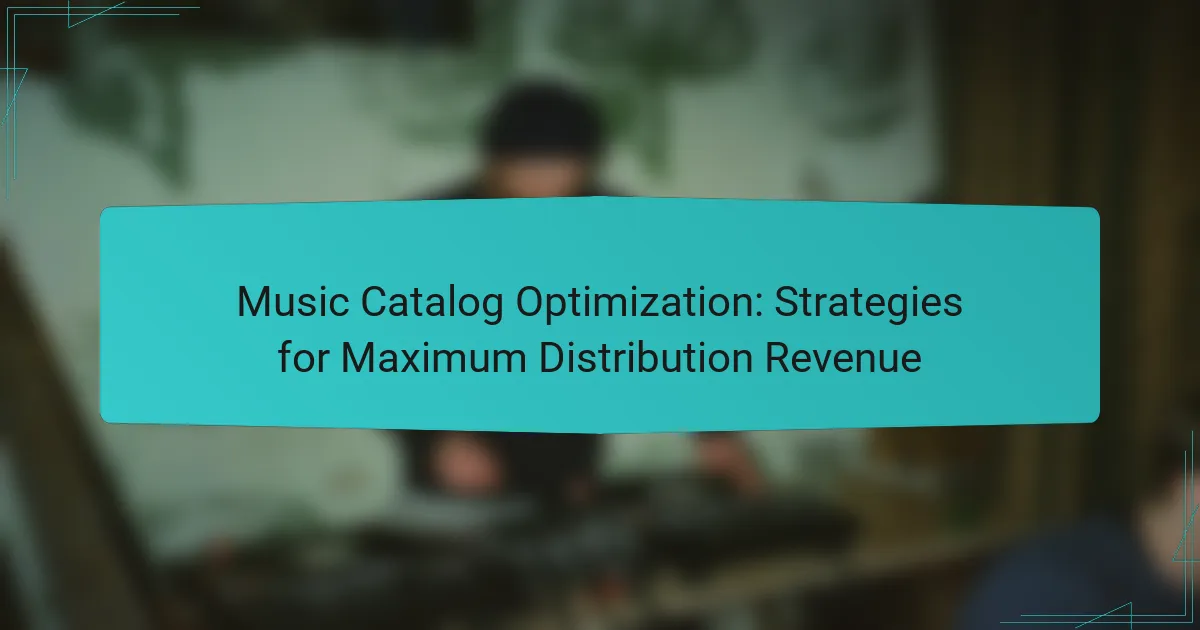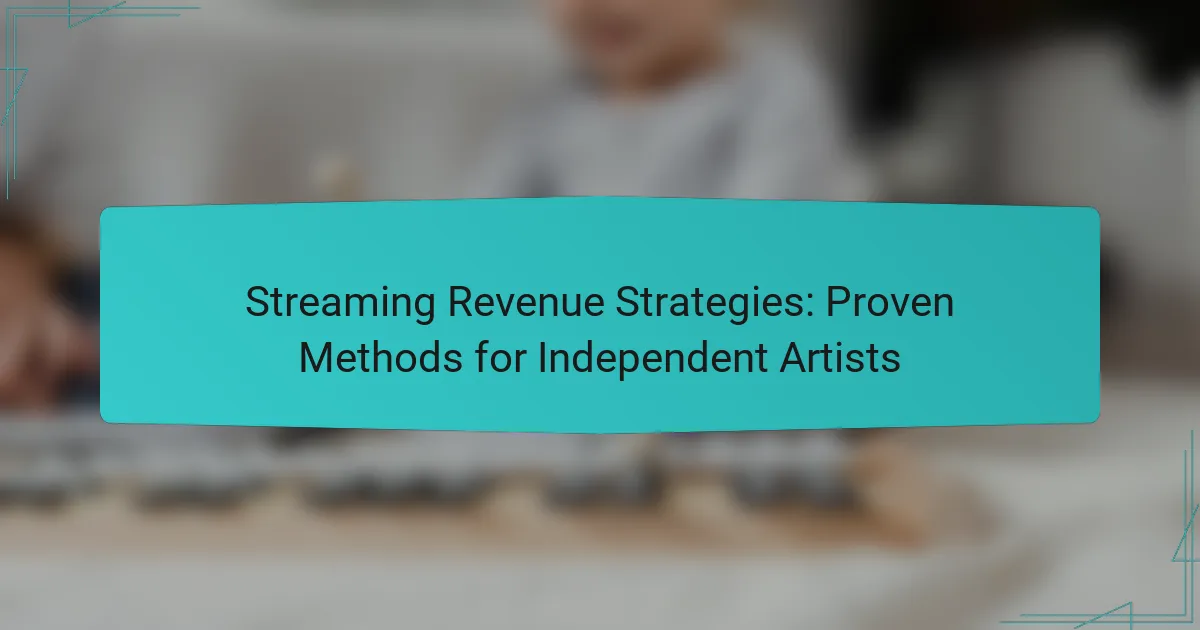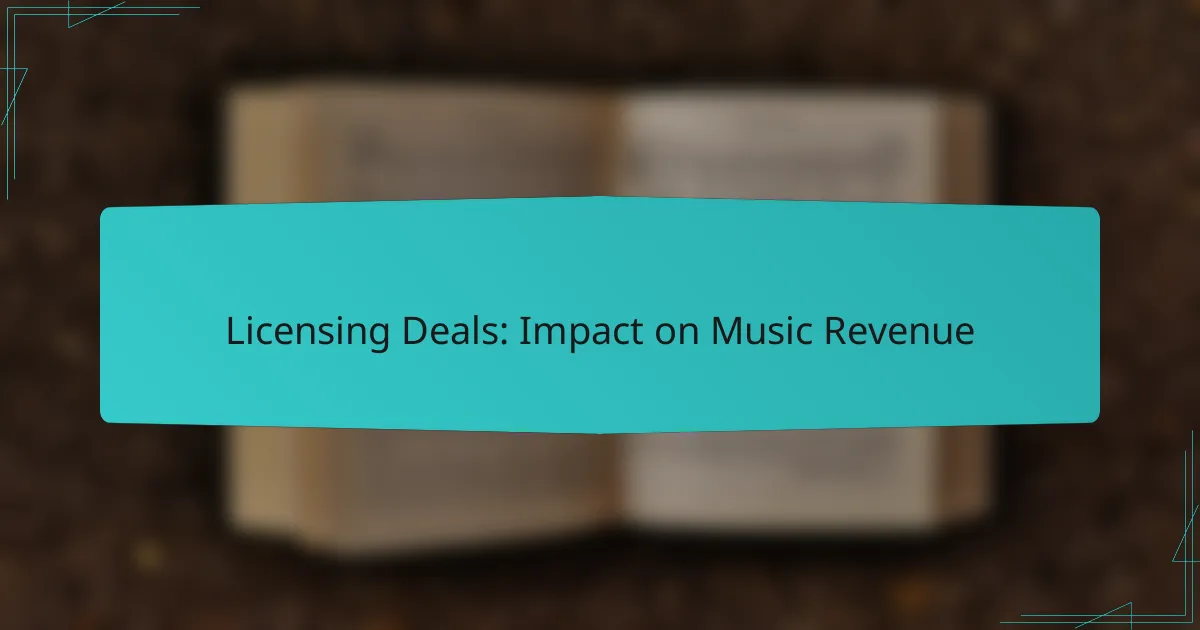Optimizing a music catalog is essential for artists seeking to enhance visibility and maximize revenue across multiple platforms. By focusing on effective metadata management, selecting the right distribution channels, and leveraging social media and data analytics, musicians can significantly improve their catalog’s performance and listener engagement.

What are effective strategies for music catalog optimization?
Effective strategies for music catalog optimization focus on enhancing visibility and maximizing revenue across various platforms. By improving metadata, utilizing distribution platforms, leveraging social media, implementing data analytics, and collaborating with influencers, artists can significantly boost their catalog’s performance.
Metadata enhancement
Enhancing metadata is crucial for music catalog optimization as it improves searchability and discoverability. Ensure that each track includes accurate titles, artist names, genres, and relevant keywords to help streaming services categorize your music effectively.
Consider adding detailed descriptions and tagging your music with mood or themes. This can attract listeners looking for specific vibes, increasing your chances of playlist placements and higher streaming numbers.
Utilizing digital distribution platforms
Choosing the right digital distribution platforms is essential for reaching a wider audience. Services like DistroKid, TuneCore, and CD Baby allow artists to distribute music across major streaming services, including Spotify, Apple Music, and Amazon Music.
Evaluate the fees and revenue splits of each platform. Some may charge upfront fees while others take a percentage of earnings. Select a platform that aligns with your financial goals and offers the best exposure for your catalog.
Leveraging social media marketing
Social media marketing is a powerful tool for promoting your music catalog. Platforms like Instagram, TikTok, and Facebook allow artists to engage directly with fans and share updates about new releases, behind-the-scenes content, and live performances.
Develop a content strategy that includes regular posts, stories, and interactive elements like polls or Q&A sessions. Collaborate with other artists or brands to expand your reach and attract new listeners.
Implementing data analytics
Data analytics can provide insights into listener behavior and preferences, helping you tailor your marketing efforts. Use tools like Spotify for Artists or Apple Music Analytics to track streams, demographics, and engagement metrics.
Analyze which songs perform best and identify trends in listener habits. This information can guide your future releases and promotional strategies, ensuring you focus on what resonates with your audience.
Collaborating with influencers
Collaborating with influencers can amplify your music catalog’s reach. Influencers often have dedicated followings that trust their recommendations, making them effective partners for promoting new releases.
Identify influencers within your genre or niche and propose collaboration ideas, such as sponsored posts or music reviews. Ensure that the partnership feels authentic to their audience to maximize engagement and impact.
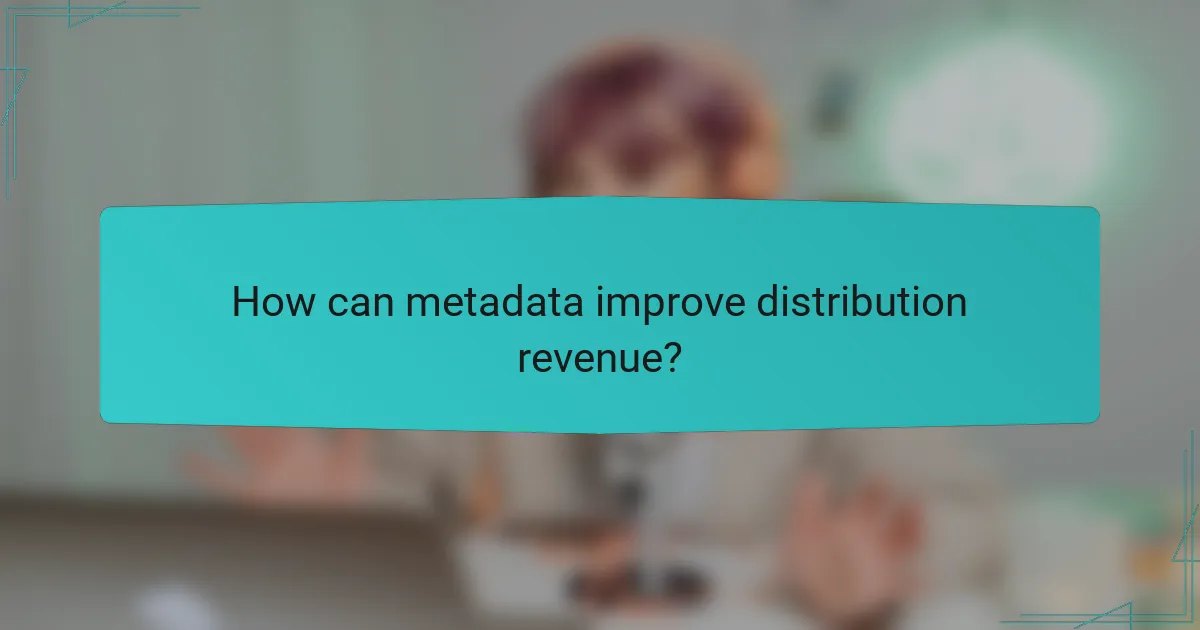
How can metadata improve distribution revenue?
Metadata plays a crucial role in enhancing distribution revenue by ensuring that music is easily discoverable and accurately categorized. Properly managed metadata can lead to increased visibility on streaming platforms, resulting in higher listener engagement and, ultimately, more revenue.
Accurate genre tagging
Accurate genre tagging is essential for connecting your music with the right audience. By categorizing your tracks into specific genres, you increase the chances of being featured in playlists and recommendations that align with listeners’ preferences. Aim for 2-3 relevant genres to maximize exposure without overwhelming potential listeners.
Consider researching trending genres within your target market to ensure your tagging aligns with current listener interests. Tools like Spotify for Artists can provide insights into genre performance and audience demographics, helping you refine your tagging strategy.
Optimizing song descriptions
Optimizing song descriptions involves crafting compelling narratives that resonate with listeners and provide context for your music. A well-written description can enhance searchability and attract more plays, so include key themes, inspirations, and any notable collaborations. Aim for 150-300 words that capture the essence of the track.
Utilize relevant keywords that potential listeners might search for, but avoid keyword stuffing. Focus on creating a natural flow that engages readers while incorporating terms that enhance discoverability on platforms like Apple Music and Amazon Music.
Using high-quality cover art
High-quality cover art is vital for making a strong first impression and attracting listeners. A visually appealing cover can significantly influence a listener’s decision to click and play your music. Ensure your artwork is at least 3000 x 3000 pixels and adheres to the specifications of major streaming platforms.
Consider hiring a professional designer or using design tools to create eye-catching artwork that reflects your music’s style and genre. Remember that cover art is often the first interaction a listener has with your music, so invest time and resources to make it stand out.

What digital distribution platforms should I consider?
When selecting digital distribution platforms, consider those that align with your music catalog’s needs and revenue goals. Key platforms include CD Baby, TuneCore, and DistroKid, each offering unique features and pricing structures to maximize your distribution revenue.
CD Baby
CD Baby is a popular choice for independent musicians, allowing you to distribute music to major streaming services and online stores. They charge a one-time fee per album or single, which means you keep 100% of your sales revenue after the initial cost.
One advantage of CD Baby is its extensive reach, including platforms like Spotify, Apple Music, and Amazon Music. Additionally, they offer services like physical distribution and sync licensing, which can further enhance your revenue potential.
TuneCore
TuneCore operates on a subscription model, charging an annual fee for each release. This allows artists to retain 100% of their sales revenue, but the costs can add up if you release multiple albums or singles each year.
TuneCore provides detailed analytics and reporting tools, helping you track your earnings and performance across various platforms. They also offer additional services such as publishing administration, which can help you collect royalties from song placements.
DistroKid
DistroKid is known for its low-cost, unlimited distribution model, allowing artists to upload as much music as they want for a single annual fee. This can be particularly beneficial for prolific artists or those releasing frequent singles.
With DistroKid, you also benefit from features like automatic revenue splits for collaborations and the ability to set up pre-orders. However, be mindful that while they offer fast distribution, customer support may not be as robust as other platforms.
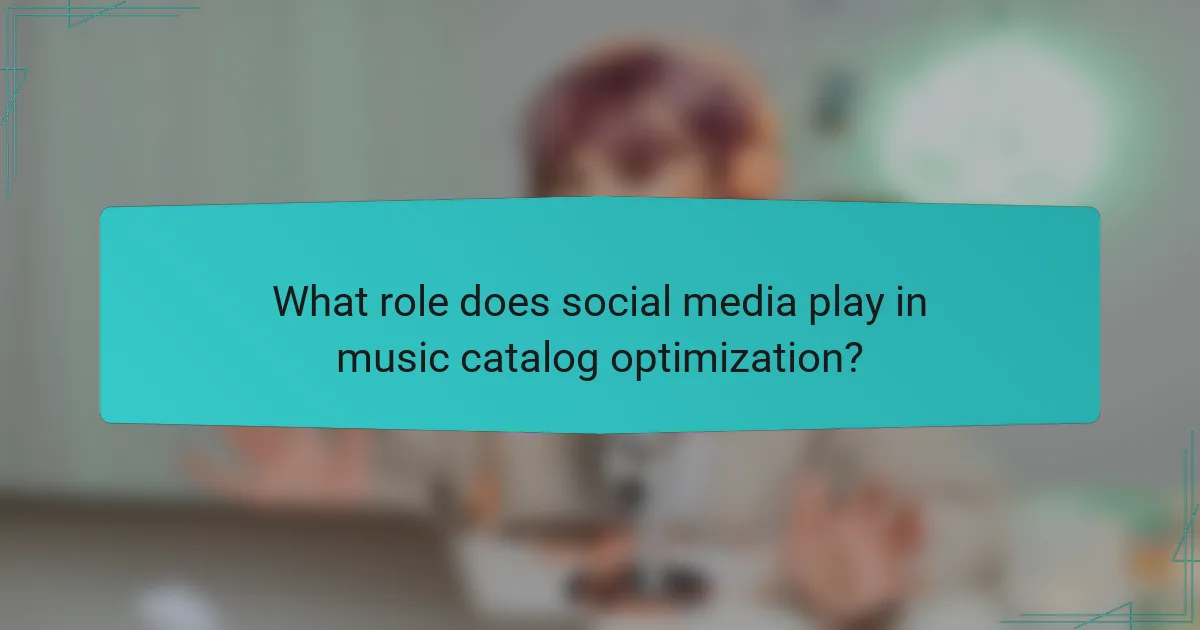
What role does social media play in music catalog optimization?
Social media is crucial for music catalog optimization as it enhances visibility and engagement, leading to increased distribution revenue. By leveraging platforms like Instagram, TikTok, and Facebook, artists can connect directly with fans and promote their music effectively.
Building an engaged fanbase
Creating an engaged fanbase on social media is essential for artists looking to optimize their music catalog. Regular interaction, such as responding to comments and hosting live sessions, fosters a sense of community. Artists should aim to post consistently, sharing behind-the-scenes content and personal stories to deepen connections.
Utilizing user-generated content, like fan covers or dance challenges, can further enhance engagement. Encouraging fans to share their experiences with the music helps create organic promotion and strengthens loyalty.
Promoting new releases
Social media serves as a powerful tool for promoting new music releases. Artists can create anticipation by teasing snippets or artwork before the launch. Countdown posts and exclusive previews can generate buzz and encourage fans to share the news within their networks.
Utilizing features like Instagram Stories or Facebook Events for release parties can also maximize reach. Collaborating with influencers or other artists for cross-promotion can expand visibility and attract new listeners.
Utilizing targeted ads
Targeted ads on social media platforms can significantly enhance music catalog optimization by reaching specific demographics. Artists should define their target audience based on age, location, and musical preferences to ensure effective ad spend. Platforms like Facebook and Instagram offer robust tools for creating custom audiences.
Setting a budget and testing different ad formats, such as video clips or carousel ads, can help identify what resonates best with potential listeners. Monitoring ad performance and adjusting strategies accordingly is crucial for maximizing return on investment.
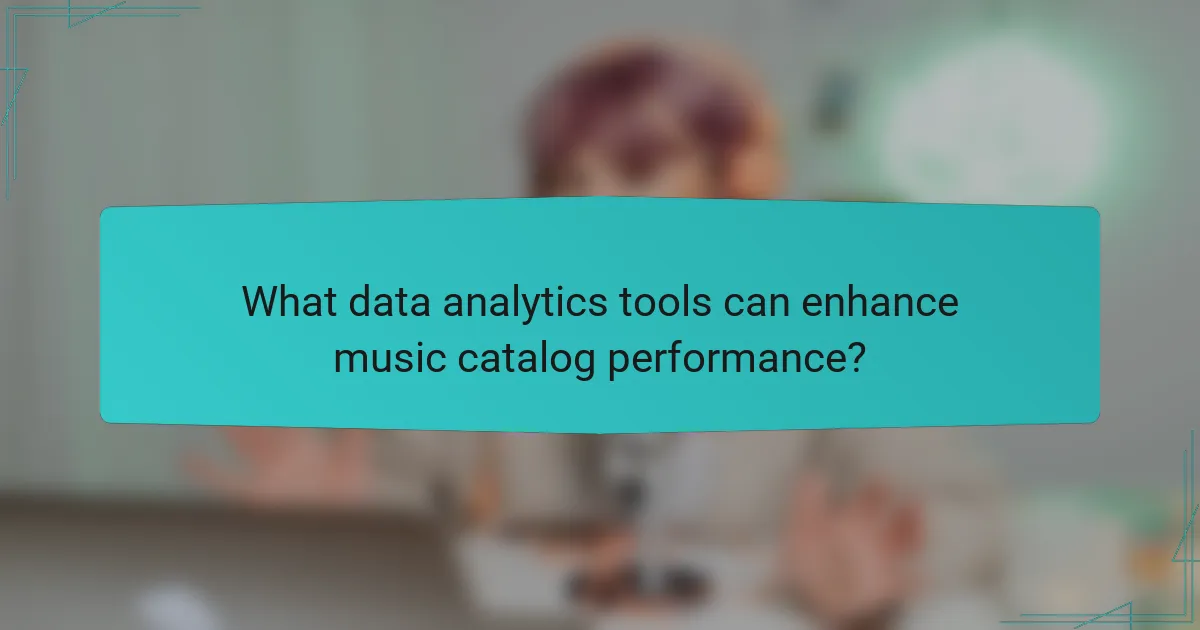
What data analytics tools can enhance music catalog performance?
Data analytics tools play a crucial role in optimizing music catalog performance by providing insights into listener behavior, engagement metrics, and revenue generation. Utilizing these tools can help artists and labels make informed decisions to maximize distribution revenue.
Spotify for Artists
Spotify for Artists offers detailed analytics that help musicians understand their audience and track performance metrics. Users can access data on streams, listener demographics, and playlist placements, which are essential for tailoring marketing strategies and enhancing visibility.
To make the most of Spotify for Artists, regularly review your audience insights and adjust your promotional efforts accordingly. For example, if a particular demographic shows high engagement, consider targeting similar listeners in your campaigns.
Apple Music Analytics
Apple Music Analytics provides artists with insights into how their music is performing on the platform, including play counts, song shares, and listener retention rates. This data is vital for understanding which tracks resonate most with audiences and can guide future releases.
Utilize Apple Music’s analytics to identify trends over time. For instance, if a specific genre or style gains traction, consider incorporating those elements into upcoming projects to align with listener preferences.
Soundcharts
Soundcharts aggregates data from multiple streaming platforms and social media, offering a comprehensive view of an artist’s performance across various channels. This tool is particularly useful for tracking global trends and identifying potential markets for expansion.
When using Soundcharts, focus on the geographic data to pinpoint regions where your music is gaining traction. This can inform targeted marketing efforts, such as localized promotions or tours, to capitalize on growing fan bases.
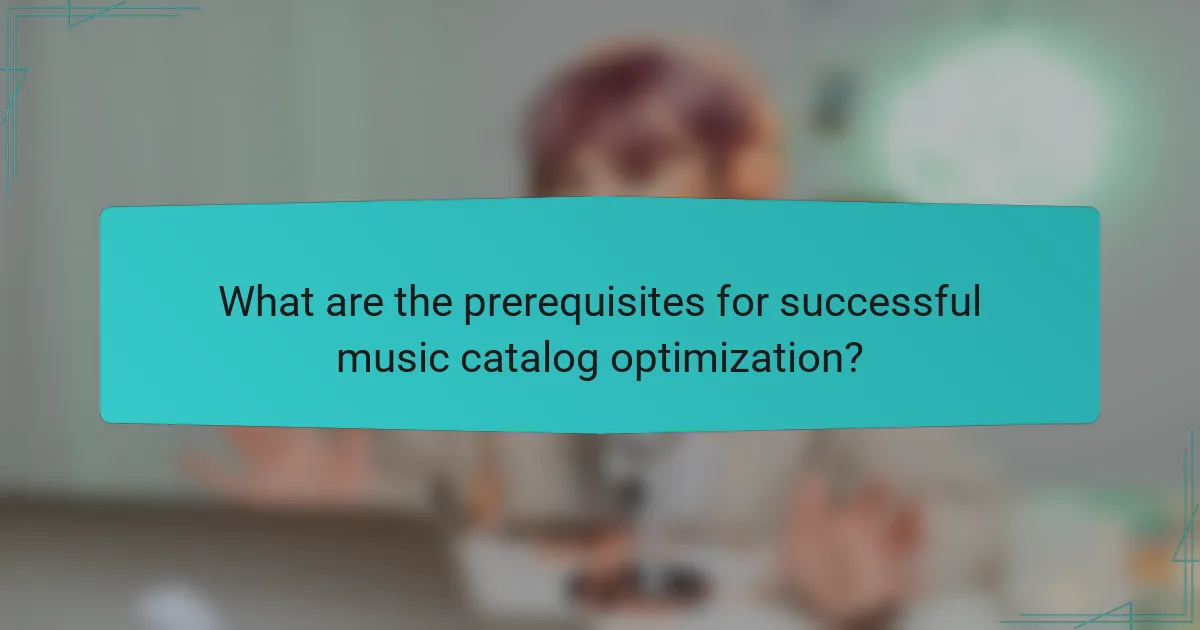
What are the prerequisites for successful music catalog optimization?
Successful music catalog optimization requires a clear understanding of your catalog’s strengths, weaknesses, and market potential. Key prerequisites include data organization, knowledge of distribution channels, and effective marketing strategies.
Data Organization
Organizing your music catalog involves maintaining accurate metadata, including artist names, song titles, genres, and release dates. Properly structured data enhances discoverability on streaming platforms and ensures that royalties are correctly allocated.
Consider using a centralized database or digital asset management system to streamline access and updates. Regular audits can help identify inconsistencies or missing information that could hinder performance.
Understanding Distribution Channels
Familiarity with various distribution channels is crucial for maximizing revenue. Different platforms, such as Spotify, Apple Music, and YouTube, have unique requirements and audience demographics.
Evaluate which platforms align best with your target audience and optimize your catalog accordingly. For example, consider focusing on platforms that cater to specific genres or demographics to enhance engagement and revenue potential.
Effective Marketing Strategies
Implementing effective marketing strategies is essential for promoting your music catalog. This includes leveraging social media, email marketing, and collaborations with influencers to reach a wider audience.
Utilize analytics tools to track engagement and adjust your marketing efforts based on performance data. Regularly refresh promotional content to keep your catalog relevant and appealing to listeners.
